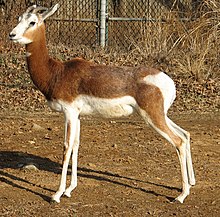Dama gazelle
| Dama gazelle | |
|---|---|
 |
|
| N. d. mhorr | |
| Scientific classification | |
| Kingdom: | Animalia |
| Phylum: | Chordata |
| Clade: | Synapsida |
| Class: | Mammalia |
| Order: | Artiodactyla |
| Family: | Bovidae |
| Subfamily: | Antilopinae |
| Tribe: | Antilopini |
| Genus: | Nanger |
| Species: | N. dama |
| Binomial name | |
|
Nanger dama (Pallas, 1766) |
|
| Subspecies | |
also see text |
|
 |
|
| Geographic range | |
| Synonyms | |
|
|
also see text
The dama gazelle, addra gazelle, or mhorr gazelle (Nanger dama, formerly Gazella dama) is a species of gazelle. It lives in Africa in the Sahara desert and the Sahel. This critically endangered species has disappeared from most of its former range due to overhunting and habitat loss, and natural populations only remain in Chad, Mali, and Niger. Its habitat includes grassland, shrubland, semi-deserts, open savanna and mountain plateaus. Their diets includes grasses, leaves (especially Acacia leaves), shoots, and fruit.
In Niger, the dama has become a national symbol. Under the Hausa name meyna or ménas the dama appears on the badge of the Niger national football team, who are popularly called the Ménas.
The dama gazelle is white with a tannish-brown head and neck. Both sexes usually have medium-length ringed horns curved like an "S". Males' horns are about 35 cm (14 in) long, while females' horns are much shorter. The gazelles' heads are small with narrow muzzles, their eyes are relatively large, and they have longer necks and legs than most gazelles. These animals are between 90 and 120 cm (35 and 47 in) tall at the shoulder, weigh between 35 and 75 kg (77 and 165 lb), and have lifespans up to 12 years in the wild or 18 in captivity. A few days following birth, dama young are strong enough to follow the herd, and after a week, they are able to run as fast as the adults.
Damas are considered the largest type of gazelle, with incredibly long legs, which provide extra surface area on their bodies to dissipate heat, one of the many ways they stay cool in their hot desert environment. They also tend to need more water than some of their desert relatives, but they can withstand fairly long periods of drought. Unlike many other desert mammals, damas are a diurnal species, meaning they are active during the day.
...
Wikipedia

